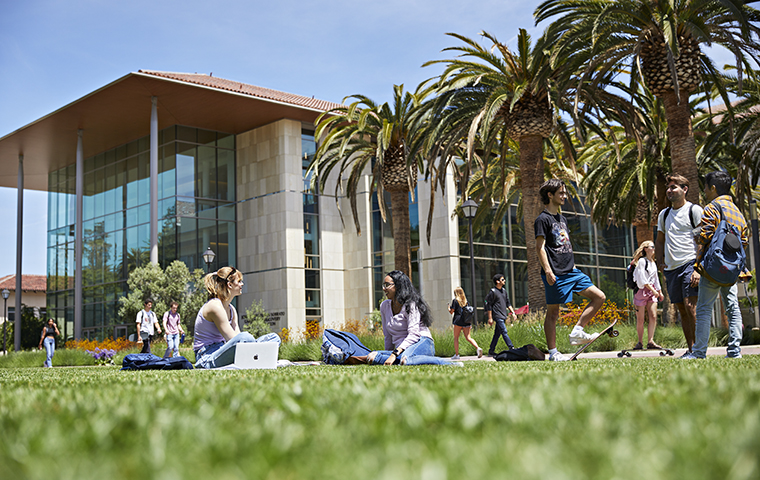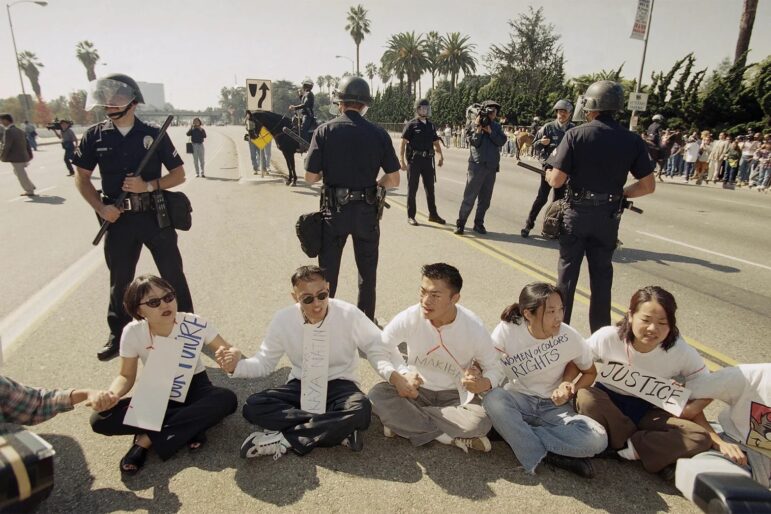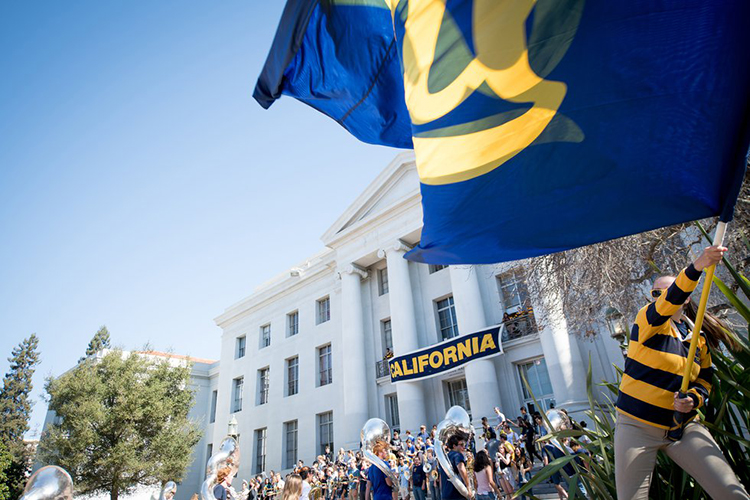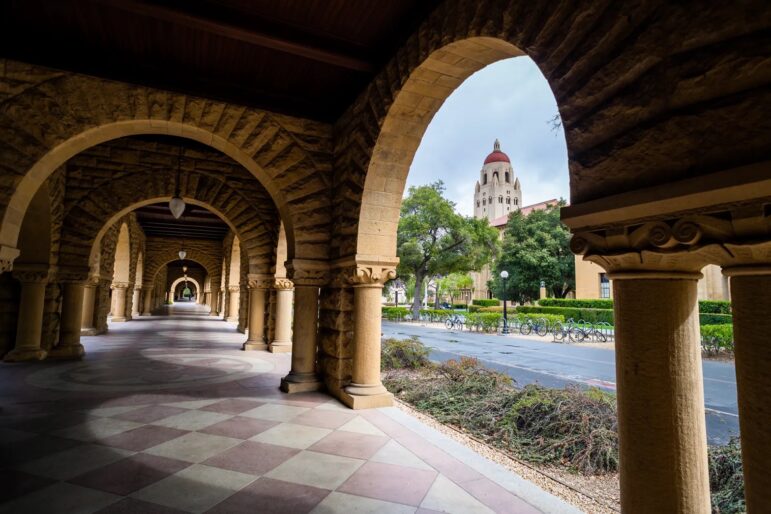As a first generation student of color, JP Flores credits much of his academic success to his ability to attend Occidental College, a small, private college in Southern California with what he describes as an inclusive culture.
“It changed my perspective on the world and changed the trajectory of my life,” said Flores, who is now pursuing a Ph.D. in bioinformatics & computational biology at the University of North Carolina at Chapel Hill.
That trajectory might have been different, Flores said, if Occidental had been barred from using affirmative action in admissions — a situation that could become reality this summer if the U.S. Supreme Court rules against the practice in two widely watched cases.
Anxiety about the ruling is mounting at the state’s private colleges, which until now have not been subject to a California law prohibiting public universities from considering race, sex and ethnicity in admissions and hiring. Administrators at those colleges are turning to alternative policies that could help boost diverse enrollment, while student activists are trying to increase awareness on their campuses about the possible impact of an affirmative action ban.

The Supreme Court is expected to rule in June on two lawsuits filed by Students for Fair Admissions — a non-profit group led by conservative legal strategist Edward Blum — after hearing arguments in the cases in October. One suit argues that Harvard University’s admission policy discriminates against Asian American applicants, while the other asserts that The University of North Carolina at Chapel Hill discriminates against Asian American and white applicants.
Although it is unclear how limited or expansive the ruling might be, many university leaders and student activists are bracing for an outright ban on affirmative action on all campuses, given the court’s conservative majority.
Flores said he worries especially about the impact on diversity in the STEM professions. He founded a podcast “From Where Does it STEM?” in 2021, where he interviews scientists from diverse backgrounds about their experiences in the field, and helps recruit and retain underrepresented minority students to STEM programs. If private universities are banned from using affirmative action, he fears, it will “only bring one perspective to the forefront.”
“I think people in science are really starting to realize that in order to solve biological problems like cancer, Alzheimer’s, or different diseases, it takes an interdisciplinary approach,” Flores said. “People really underestimate the power of having a diverse scientific workforce behind these problems.”
Some California private universities have flagged that an affirmative action ban could constrain their ability to review applications holistically — taking into account all aspects of an applicant’s identity, including experiences, attributes and academic metrics.
A holistic admissions process is essential to creating a student body that equips “students to become the citizens of the world (needed) to meet the greatest needs of our society,” said Eva Blanco Masias, the vice president of enrollment at Santa Clara University.
And race is often deeply embedded in a student’s application, said Masias — not just in the demographic information, but also in their essays. Students often write about life experiences, where race can play a factor, she said.
While it’s impossible to predict the court’s ruling, “there might be some limitations put on institutions’ ability to consider race (and) ethnicity as one of many, many factors in holistic admissions,” said Julie Park, an associate professor of education at the University of Maryland, College Park.
“So is that going to be some sort of limitation? Is that going to be an outright ban? We don’t really know,” said Park, who has studied race and admissions for nearly two decades and served as a consulting expert for Harvard on the SFFA case until 2018.
Another concern is that students from underrepresented backgrounds, aware of the ban, might opt out of applying to private colleges, said Kristen Soares, president of the Association of Independent California Colleges and Universities, a trade group of more than 80 colleges.
“People know about this decision being debated right now in the highest court of law in the nation,” she said. Private colleges, she said, are “really worried” that families might interpret a potential affirmative action ban as a message: “You’re not welcome at these institutions.”
Flores, who now mentors high school students and serves as an alumni interviewer for prospective Occidental College students, echoed that concern. “A lot of students from underrepresented backgrounds, they are so scared to just even apply because they feel they’re not qualified.”
And that can have a ripple effect on diversity among graduate students, he said: “A big part of getting underrepresented students to get their Ph.Ds or MDs or even a master’s degree is to make sure they can actually get to undergrad.”
Motivated in part by the Supreme Court cases, the association this year launched the California Private College is Possible Alliance, a joint outreach effort that works with high school and community college counselors to break down barriers that might prevent low-income students and students of color from pursuing private education.
The alliance has created a centralized landing webpage where counselors can find information about private colleges throughout the state, including their application process, available financial aid and unique programs they offer. It plans to host college fairs across the state for high school and community college students.
“We want to be loud and clear that they should not (opt themselves out),” said Masias, whose university is participating. “Still be intentional and strive for your educational aspirations. We’re still here. We still welcome you. Please apply.”
However, Zachary Bleemer, a Yale economics professor who studied the impact of affirmative action at the University of California before California’s Proposition 209 made it illegal in 1996, notes that these initiatives might not be as effective as affirmative action.
He compared affirmative action to two alternative UC policies to increase representation of underrepresented minorities, a category that includes Black, Hispanic, and Native American students.

Bleemer studied the admissions cycles between 1994 and 2021 and found that both alternatives — guaranteeing UC acceptance to the top 9% of California students and holistic application review — had a much smaller impact than race-based affirmative action. While affirmative action increased underrepresented minority enrollment by over 20%, the UC’s top percent policies increased it by less than 4% and holistic review by about 7%, he found.
“Despite the fact that universities are going to go out of their way to try to implement replacement policies for race-based affirmative action to maintain diversity on campus, nevertheless, diversity is going to fall, Black and Hispanic enrollment and expectation is going to fall, at selective private universities,” Bleemer predicted.
At UC Berkeley and UCLA, the two most competitive campuses in the UC system, underrepresented minority enrollment dropped significantly after Proposition 209, plunging by about 50 percent at Berkeley.
Although underrepresented minority enrollment on those campuses has increased during the past 30 years, it does not reflect those groups’ share of California high school graduates, and Black student enrollment still has not returned to pre-Prop 209 levels.
The ban led to a cascade effect, Bleemer said, where Black and Latino students fell down the ladder of selectivity within UC and it ultimately pushed some students who were at the bottom completely out of higher education.
“Kids who had previously gone to Berkeley, the affirmative action ban goes into place, now they go to Davis. Kids who were previously going to Davis now go to Riverside, etc,” Bleemer said. “So you see this sort of shift of the full distribution of Black and Hispanic students into somewhat less selective universities.”

UC Berkeley has partially reversed that trend; for the freshman class of 2020, Black and Latino enrollment increased by about 40% over the previous year and has stayed steady since.
Olufemi Ogundele, the university’s dean of undergraduate admissions, said since being hired in 2019, he’s focused on altering three aspects of the admissions process: student outreach, application evaluation, and messaging.
He and his team worked to ensure that their outreach was tailored to the specific needs of the students and communities they were speaking to. Given how selective UC Berkeley is, he noted that “it’s not just about going out into communities and talking about coming to Berkeley. It’s much more about going out into communities and talking about college options that they have, and using Berkeley as a template to describe those options for those families.”
He worked to “humanize the evaluation process” by requiring admissions counselors to have “local expertise on the environments that they were reading from.”
“This has been allowing diverse versions of excellence to emerge in our evaluation process, which has been incredibly helpful, especially when we start thinking about geographic range, which we’ve been trying to really capture, as we are a public flagship trying to represent the entire state, and not just pieces of it,” Ogundele said.
Ogundele also stressed the importance of ensuring that every admitted student understands their value to the university.
“We changed our messaging from ‘You’re so lucky to be here’ to ‘We are lucky to have you,’ ” he said.
Based on UC’s experience, Bleemer predicted that a nationwide affirmative action ban would cause declines in Black and Latino enrollment at California’s highly selective private colleges such as Stanford University and the University of Southern California. The effect could be muted, however, if there’s less student awareness about the Supreme Court’s decision than there was about Proposition 209 in the 1990s, he said. And part of the decline at UC was driven by the fact that students had other high-quality options, including private schools across the country and public schools outside of California, where affirmative action was still in effect. A nationwide affirmative action ban would change that picture, he said.
Much of the concern at California’s private universities has revolved around diversity within STEM fields.
Stanford University filed an amicus brief in support of Harvard last November. As one of the nation’s most selective colleges, with a roughly 4% acceptance rate, the university argued that an affirmative action ban would particularly negatively impact its programs in STEM, “which has historically been marked by greater limitations in diversity than most fields of study.”
Stanford student Phong Nguyen is part of the 22% Campaign, a student-led initiative that works to increase representation of Southeast Asian students on campus, including those from Hmong, Lao, Khmer, and Tibetan communities. The initiative has led protests, coordinated high school outreach programs and called for Stanford to disaggregate its admissions data so that these Asian communities can be recognized as underrepresented.

During his time on campus, Nguyen — a first generation and Asian American student — has joined the Asian American Theater club on campus and spent time in Okada House, Stanford’s Asian American cultural-themed dorm.
He said he worries that an affirmative action ban could decrease diversity in the student body and negatively impact race-based student groups that make him feel more at home at a predominantly white and wealthy institution like Stanford.
“A huge part of what has made my experience at Stanford University so enjoyable are those cultures that I’ve been exposed to,” Nguyen said.
“There is some sort of beauty in the phrase ‘Everyone is going to a different Stanford’ and I think the Stanford I’m going to is quite beautiful now and I don’t want that to change.”
Nguyen has partnered with Asian Americans Advancing Justice, a national nonprofit legal aid and civil rights organization, to spread awareness about a possible affirmative action ban through tabling on campus and leading a teach-in alongside Stanford ethnic studies professors. The teach-in focused on the history of affirmative action and how an end to the admissions policy could impact discussions and learning in ethnic studies courses.
The Stanford College Republicans, on the other hand, would view a Supreme Court ruling against affirmative action as a win, said their president, Seamus Callaghan.
Affirmative action seeks “to draw out racial divisions within our country,” Callaghan said in a statement to CalMatters.
“All American communities, regardless of racial makeup, deserve to prosper, but affirmative action in hiring and admissions has done little to advance this cause,” he said. “It does nothing to address the underlying causes of continued racial disparities, such as differences in grade school quality, the epidemic of fatherlessness, or a culture of grievance that suppresses wealth creation.”
Park, the University of Maryland education professor, said that despite some students’ fears, a Supreme Court ruling is unlikely to impact race-based student groups or scholarships. But some universities, she said, might “overread” the decision, and impose restrictions beyond the scope of the ruling. This is already starting to happen in places where race-conscious admissions are still legal, Park said.
“We’ve seen for instance, institutions have made sort of shifts in things like scholarship programs or other initiatives. Scholarships that used to be explicitly for, say, BIPOC students are now kind of diversity scholarships that white students can receive,” Park said. “Some of these steps have been done even while race conscious admissions is still the law of the land.”
Ogundele described affirmative action as a “necessary band-aid solution that our profession has used,” and its potential loss as an opportunity for universities to look deeper at how to solve educational disparities.
“If the results from the Supreme Court case come back in a way that does create a national ban on the ability to use race, I think it would be a real gut check moment for many institutions to understand, well, what is your true commitment to diversity and to equity?” he said.
A particularly challenging part of his job, he said, has been increasing Black students’ application and enrollment numbers at Berkeley.
“When we take a look at all of these institutions across all nine of the states that have similar bans like Prop 209, it is Black people for the most part are the most impacted by these types of bans,” Ogundele said. “So that’s my greatest fear — is what does this mean for Black enrollment at highly selective and highly resourced institutions?”
Luna is a fellow with the CalMatters College Journalism Network, a collaboration between CalMatters and student journalists from across California. This story and other higher education coverage are supported by the College Futures Foundation.
